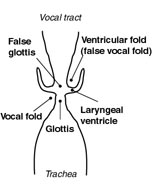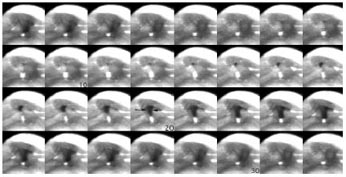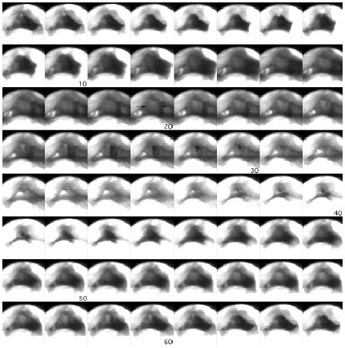First Pan-American/Iberian Meeting on Acoustics, Cancun
[ Lay Language Paper Index |
Press Room ]
Observation of Laryngeal Movements for Throat Singing
Vibrations
of two pairs of folds in the human larynx
Ken-Ichi
Sakakibara*1, Tomoko Konishi, Emi Zuiki Murano*2, Hiroshi
Imagawa*2, Masanobu Kumada*3, Kazumasa Kondo*4,
and Seiji Niimi*5
*1 NTT Communication
Science Laboratories, 3-1, Morinosato Wakamiya, Atsugi-shi, 243-0198, Japan
http://www.brl.ntt.co.jp/people/kis/
,kis@brl.ntt.co.jp
or k_i_s@hotmail.com
*2 The University of Tokyo, Japan
*3 National Rehabilitation Center for the Disabled, Japan
*4 Asian University, Japan
*5 International University of Health and Welfare, Japan
Popular version of paper 2pMUa1
Presented Tuesday Afternoon, December 3, 2002
144th ASA Meeting, Cancun, Mexico
1. Singing voices of the world
In the world, there are various styles
of singing. These variations in voices are mainly associated with variations in
timbre. Such diversity of singing voices might have arisen due to cultural diversity
such as climate, geography, language, racial physical feature, religion, musical
structure, and so on. As a matter, we can find considerable differences between
European traditional or classical singing voice, such as bel canto and
German lied, and the Asian traditional pressed singing voices, such as
throat singing around the Altai mountains, Japanese Youkyoku, and Korean Pansori.
For instance, European traditional singing styles were developed as a result of
performing in stone-made acoustical environment. Therefore, it requires constant
timbre. On the other hand, most Asian singing styles were developed as result
of performing in acoustical environment of softer material such as wood and mud.
Therefore, it requires a rich and varied timbre. It's possible to infer that singing
styles and music structures (polyphonic in Europe and homophonic in Asia) have
evolved by interacting with each other. Here, we study throat singing, which is
one of the most sophisticated styles of pressed-type singing voices, and how its
laryngeal voice is generated.
2. Throat singing
Throat singing is the traditional singing
style of people who live around the Altai mountains. Khöömei in Tyva and
Khöömij in Mongolia are representative styles of throat singing. Throat
singing is sometimes called biphonic singing, or overtone singing because two
or more distinct pitches (musical lines) are produced simultaneously in one tone.
One is a low sustained fundamental pitch, called a drone, and the second is a
whistle-like harmonic that resonates high above the drone. Sometimes throat singing
mean wider styles including all the biphonic singing styles not restricted to
the styles around the Altai mountains: e.g. Inuit, Xhosa, and so on. But here
we use the term "throat singing" for the common styles around the Altai mountains:
Khöömei, Khöömij, Kai in Altai, and so on.
The production of the highly pitched overtone of throat singing is mainly due
to the pipe resonance of the cavity from the larynx to the point of articulation
in the vocal tract, which appear as the 2nd formant in its sound spectrum. On
the other hand, the laryngeal voice of throat singing has a special pressed timbre
and supports the generation of the overtone.
The laryngeal voices of throat singing can be classified into two voices: (i)
squeezed voice (soundfile); and (ii) kargyraa voice (
soundfile). based on the listener's impression, acoustical characteristics,
and the singer's personal observation on voice production. The pressed voice is
the basic laryngeal voice in throat singing and used as drone. The equivalent
voice is used in Japanese Naniwabsuhi. The kargyraa voice is a very low pitched
voice that ranges out of the modal register. The kargyraa voice is very basic
in Kai and perceptually identical to Tibetan chant.

|
Fig.
1: Coronal section of human larynx
3. Ventricular folds (or false
vocal folds): Another pair of folds than vocal folds in human larynx
The ventricular folds or false vocal
folds (VTFs) are a pair of soft and flaccid folds which exist above the vocal
folds (Fig. 1). While the vocal folds (VFs) have a mechanism that change the stiffness,
thickness, and longitude by the muscles (mainly by the action of thyroarytenoid
muscle), the VTFs are incapable of becoming tense, since they contain very few
muscle fibres. It seems that the VTFs are capable of moving with the arytenoid
cartilages. They are also abducted and adducted by the action of certain laryngeal
muscles. The VTFs as well as the VFs act as air traps from lungs and prevent foreign
substances from entering the lower respiratory tract. In normal phonation, the
VTFs do not vibrate. But among some patients with dysphonia, the vibration of
the VTFs is sometimes observed.

|
Fig.
2: High speed digital imaging system
4. Vocal fold and ventricular
fold vibrations
We observed laryngeal movements in
throat singing directly and indirectly by simultaneous recording of high-speed
digital images, and EGG (Electroglottography) and sound waveforms (Fig. 2). The
high-speed digital images were captured at 4500 frames/s through a flexible endoscope
inserted into the nose cavity of a singer.
We obtained the following results from our observation. The common features of
the squeezed and kargyraa voices which are an overall constriction of the supra-structures
of the glottis and vibration of the VTFs. The difference lies in the narrowness
of the constriction and the manner of VTF vibration. In the squeezed voice, the
VTFs vibrate at the same frequency as the VFs and both vibrate in the opposite
phase (Fig. 3). In the kargyraa voice, the VTFs can be assumed to close once for
every two periods of closure of the VFs, and contribute to the generation of the
subharmonic tone of kargyraa (Fig. 4).
 |
|
Fig. 3: High-speed images
of the laryngeal movement for squeezed voice
|
|

|
|
Fig. 4:
High-speed images of the laryngeal movement for kargyraa voice
|
5. What is a beautiful singing
voice?
Throat singers are able to keep healthy,
clear, and beautiful voices though they use pressed-type voices which are regarded
to be a non-preferable phonation in European traditional musical pedagogy. They
are able to use VTFs as well as VFs and produce their preferable voices without
hurting their phonatory organs. Moreover, anyone can become skilled at producing
these laryngeal voices.
Thus, the phonation of throat singing is natural and not mysterious.
Acknowledgments
We would like to thank Kiyoshi Honda,
Koichi Makigami, Caroline Menezes, Johan Sundberg, and Masahiko Todoriki for their
helpful discussions.
References
- S.Adachi and M.Yamada, An acoustical
study of sound production in biphonic singing, Xöömij. J. Acoust.
Soc. Am., 105, pp.2920--2932, 1999.
- T.C.Levin and M.E.Edgerton,
The throat singers in tuva. Scientific American , Sep-1999, pp.80--87,
1999.
- L.Fuks, B.Hammarberg, and J.Sundberg,
A self-sustained vocal-ventricular phonation mode: acoustical, aerodynamic
and glottographic evidences. KTH TMH-QPSR, 3/1998, pp.49--59, 1998.
- H.Imagawa, K.-I.Sakakibara,
T.Konishi, and S.Niimi, Throat singing synthesis by a laryngeal voice model
based on vocal fold and false vocal fold vibrations. Proc. of Study Group
on Musical Info., 01-MUS-39, pp. 71--78, Info. Processing Soc. Jpn., in
Japanese, 2001.
- P.-Å. Lindestat, M.Sodersten,
B.Merker, and S.Granqvist, Voice source characteristics in mongolican "throat
singing" studied with high-speed imaging technique, acoutic spectra, and inverse
filtering. J. Voice, 15, pp. 78--85, 2001.
- K.-I.Sakakibara, S.Adachi, T.Konishi,
K.Kondo, E.Z.Murano, M.Kumada, M.Todoriki, H.Imagawa, and S. Niimi, Analysis
of vocal fold vibrations in throat singing. Tech Rep. Musical Acoust.
of Acoust. Soc. Jpn., 19-4, pp. 41--48, in Japanese, 2000.
- K.-I.Sakakibara, T.Konishi,
K.Kondo, E.Z.Murano, M.Kumada, H.Imagawa, and S.Niimi, Vocal fold and false
vocal fold vibrations and synthesis of khoomei. Proc. of ICMC, pp.
135-- 138, 2001.
- K.-I.Sakakibara, H.Imagawa,
S.Niimi, and N.Osaka, Synthesis of the laryngeal source of throat singing
using a 2x2-mass model. Proc. of ICMC, pp. 5 -- 8, 2002.
[ Lay
Language Paper Index | Press Room ]


